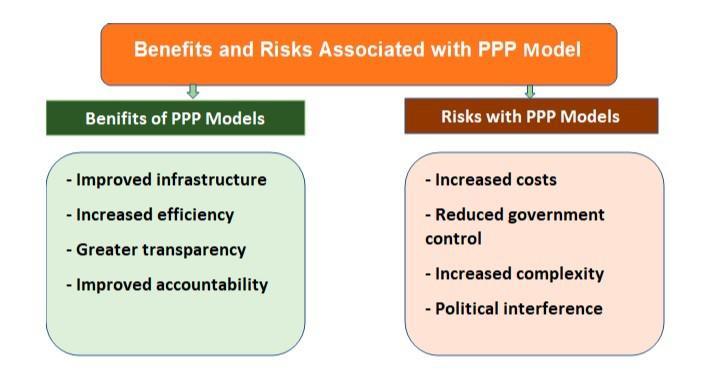Mains Daily Question
Oct. 6, 2023
Q2. In what ways do governments depend on private sector participation and collaboration to facilitate infrastructure investment, considering that public financing is often inadequate for such large-scale projects? Enumerate various forms of public-private partnerships (PPPs) that governments engage in with the private sector to expand infrastructure in the country. (10M/150W)
Approach
Introduction:
Type 1: Define Public-private partnerships (PPPs) and its significance for economic growth
Body:
Heading 1: Discuss the limitations of public financing and highlight the benefits of private sector involvement, including expertise, innovation, and efficiency.
Heading 2: Explain different types of PPPs, such as BOT, BOOT, DBO, etc., and describe the characteristics and advantages of each PPP model.
Conclusion: Highlight the role of PPPs in expanding infrastructure and addressing the challenges of public financing.
Answer:
Public-private partnerships (PPPs) involve collaboration between government entities and private sector organizations, typically for infrastructure or service delivery projects. It involves sharing of risks, responsibilities, and resources, combining the expertise and efficiency of the private sector with the public sector's regulatory and service delivery role to achieve mutual objectives. By leveraging PPPs, projects can be expedited or even made feasible, providing significant advantages in terms of project completion and realization.
Ways governments depend on private sector participation and collaboration:
- Inadequacy of public financing: Public financing is often inadequate for large-scale infrastructure projects due to budget constraints and competing priorities, such as healthcare and education.
- For example, the development of a new high-speed rail network may require significant capital investment, exceeding the available public funds.
- Leveraging private sector expertise and innovation: Governments lack expertise to manage large-scale projects, while the private sector excels in project management. Leveraging private sector experience ensures timely and cost-effective completion of infrastructure projects.
- For example, private sector expertise in airport design, construction, and operations ensures excellence in new airport development.
- Sharing financial risks and costs: Public-private collaboration shares financial risks and costs, reducing the burden on public finances.
- For example, toll road partnerships entail private sector assuming construction costs, operating risks, and generating revenue through toll collections.
Forms of public-private partnerships (PPPs) for infrastructure expansion:
- Build-Operate-Transfer (BOT): It is a conventional PPP model where the private sector is responsible for designing, building, operating, and eventually transferring the facility back to the public sector. The private sector brings the financing and takes on construction and maintenance responsibilities while being permitted to collect revenue from users.
- For example, the national highway projects contracted out by NHAI under PPP mode.
- Hybrid Annuity Model (HAM): The public entity provides 40% of the project financing, while the private entity is responsible for financing the remaining 60% In this model. The public entity retains ownership and operational control, with the private entity contributing engineering expertise.
- For example, the Zojila Tunnel Project in Jammu and Kashmir, aimed at improving connectivity to the Leh-Ladakh region, is being developed under the HAM model.
- Operate-Maintain-Transfer (OMT): Private entity is responsible for operating and maintaining an existing infrastructure facility for a specified period and ownership eventually transfers back to the government.
- For example, Hyderabad International Airport was privatized under the OMT model, with a private consortium operating and maintaining it for 30 years.
- Build-Operate-Lease-Transfer (BOLT): The government grants a private entity the rights to construct, own, and lease a facility to the public sector, with ownership transferring back to the government at the end of the lease period.
- Build-Operate-Transfer (BOT) Annuity: The private entity is responsible for designing, building, managing, and maintaining the asset, receiving a fixed annuity from the public entity throughout the contract duration, mitigating their risk.
- For example, the NHAI adopts this model for highway projects with limited revenue potential.
Public-private partnerships (PPPs) have become instrumental in driving infrastructure development in India. By attracting private investment, sharing risks, and expediting project completion, these partnerships empower the government to meet infrastructure demands, foster innovation, and enhance the overall quality of infrastructure assets.


